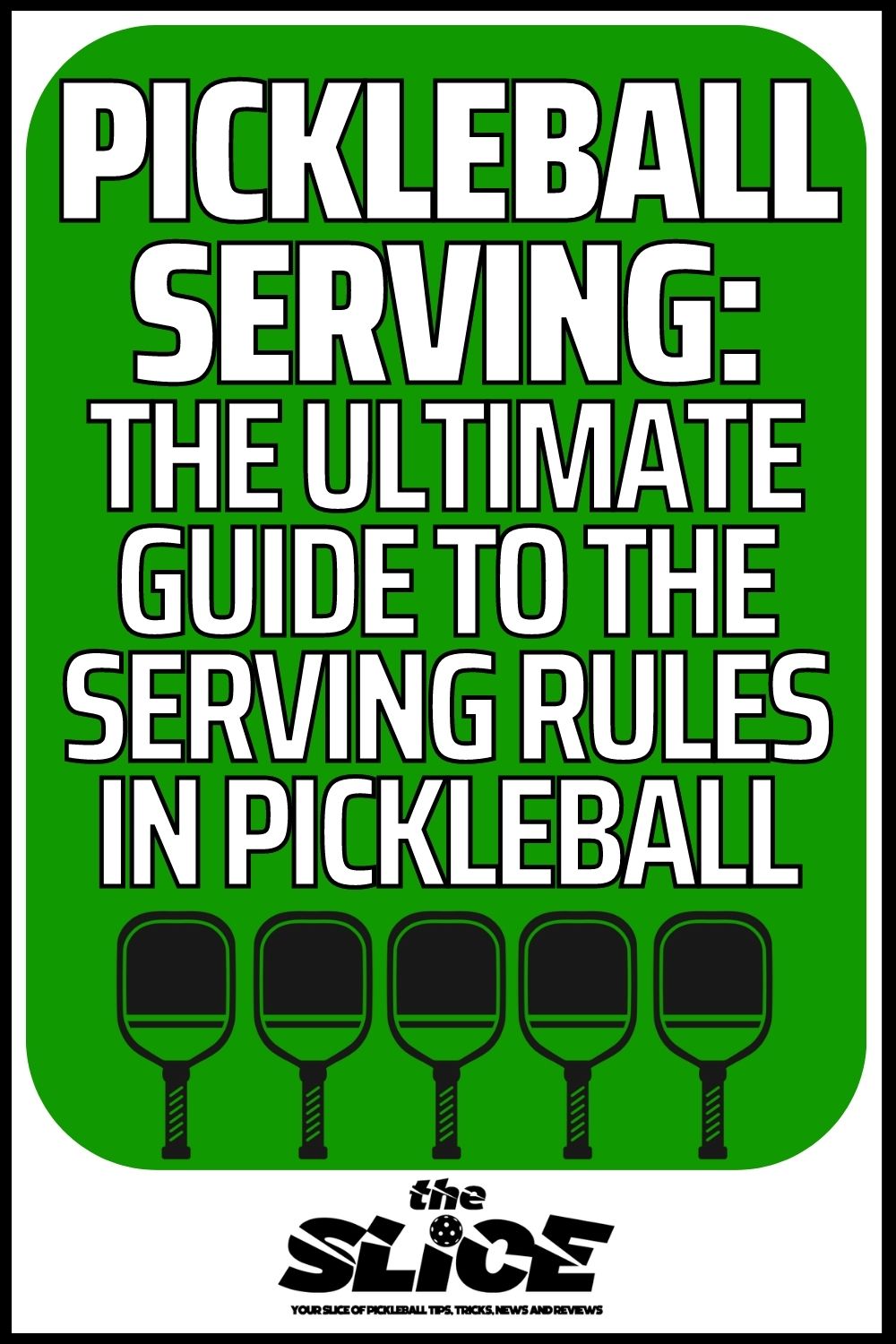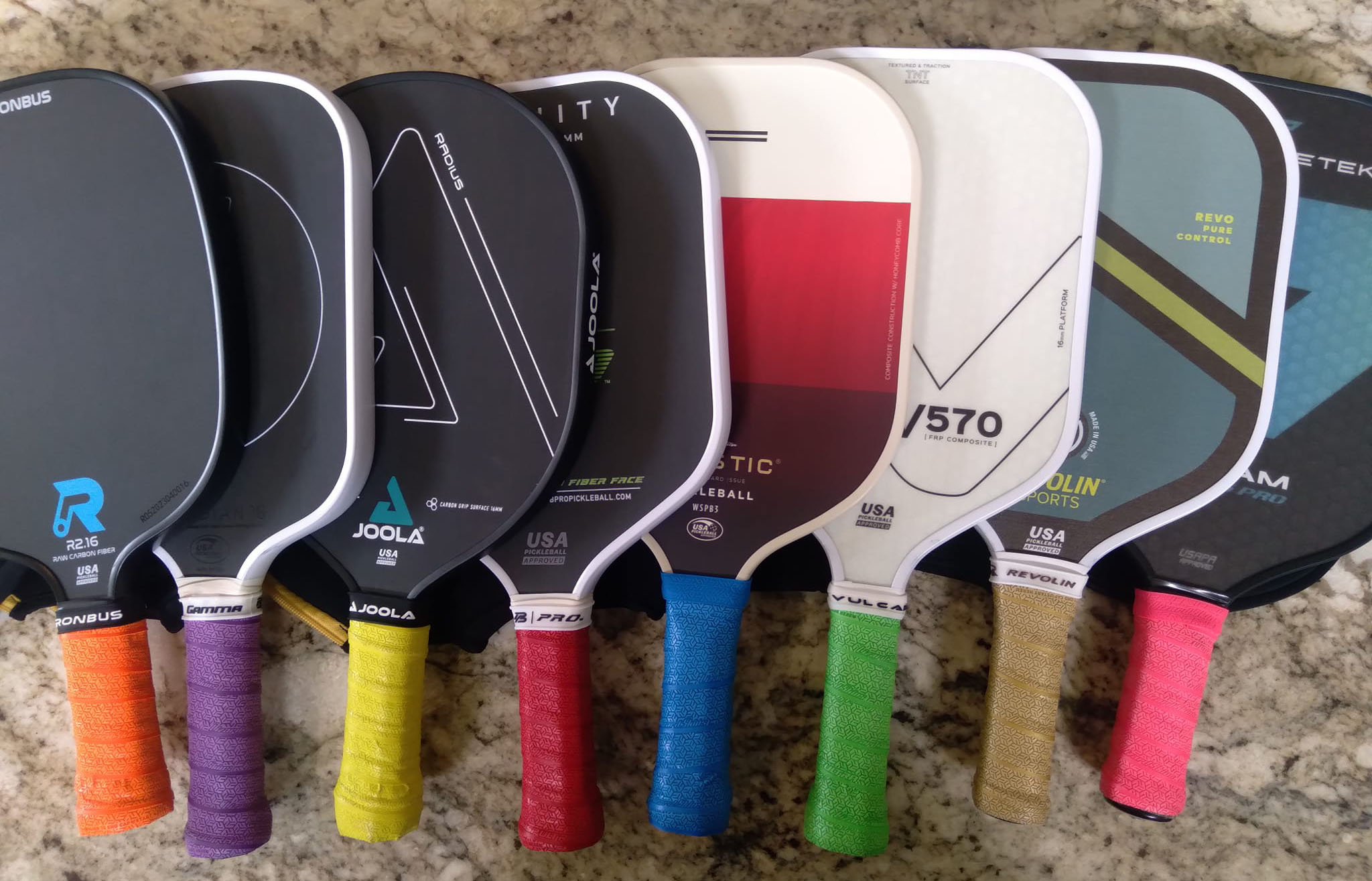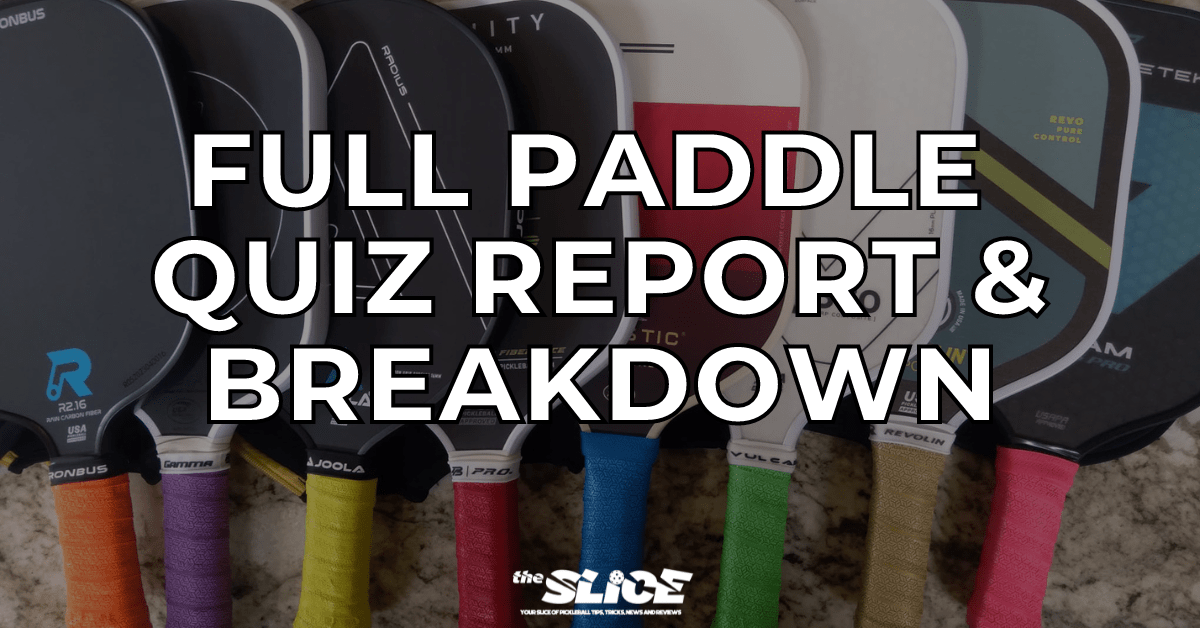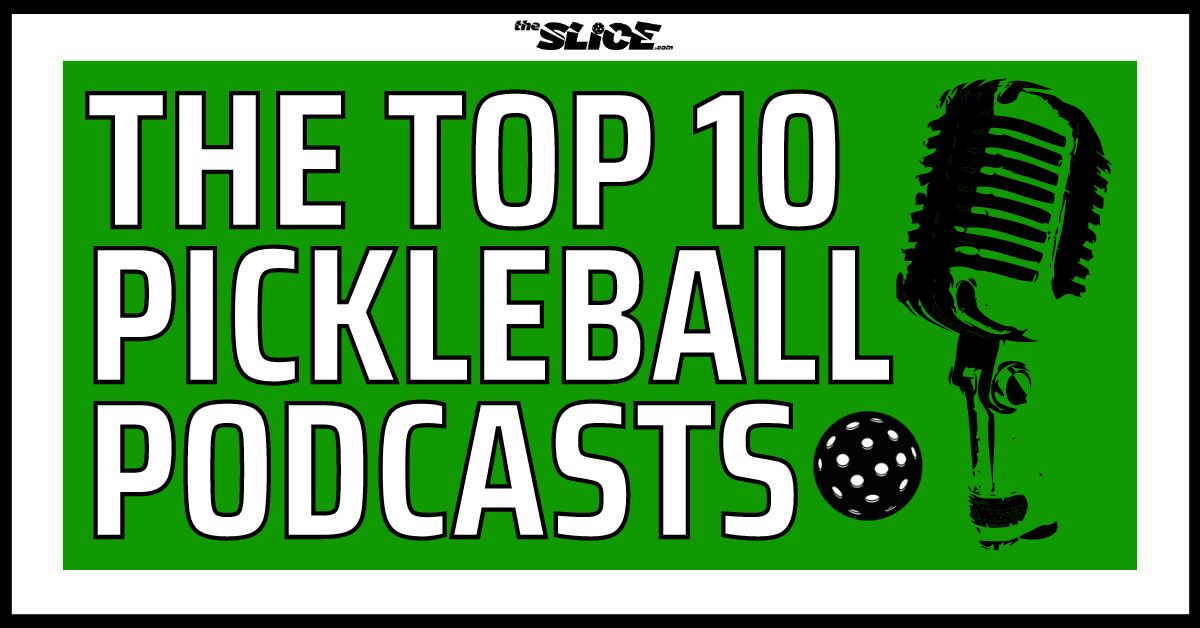
Pickleball serving rules can be a bit confusing when you first get started - especially since a lot of recreational players tend to give out the wrong information at times - and the serving rules in pickleball have changed a few times.
With serves like the spin serve being banned, we have two specific serve types that area allowed - The Drop Serve, and The Volley Serve - but that's not the only thing you need to know about the rules.
We'll be breaking down the types of serves, the specific serving rules and how they tie into pickleball scoring rules, switching sides, what is in and what is out on a serve, and much more.
I'll also be sharing some of the best serves among professional pickleball players so you can check them out, including players who have bring some attention to themselves with how close they get to their serve being illegal.
Oh, and of course you'll also see Zane Navratil multiple times below as we discuss the banned spin serve a bit (which he was notorious for), and even the Nasty Nelson (although it isn't named after him, it doesn't mean he doesn't snipe people with it).
Before we move on I do want to give you some basics that you should remember from our pickleball scoring guide that carry into our pickleball serving rules:
- Player Positioning: The player on the right service court will always serve first for a team (regardless of which player ends up on that side when you lose your serve).
- Scoring Points: You can only win points when it is your team’s serve.
- Side Out: In Pickleball a "Side Out" is when a player/team loses possession of a serve.
- Side Out Scoring: Side Out Scoring refers to the type of scoring used in most recreational play and professional play (other than MLP) and means you can only score on your serve and you continue serving until you lose a rally, and then either your partner or the other team gets the possession (depending on if your partner has served yet or not).
Most of this should be refresher points from the scoring guide, but if not don't worry, I'll be going over these and much more below as we do a deep dive into pickleball serving rules, and how you can improve.
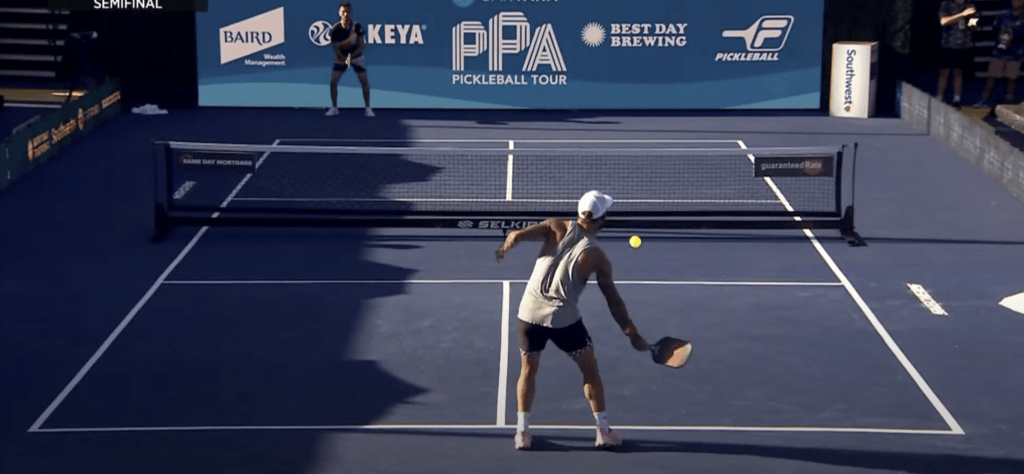
Pickleball Serving Rules: The Basics
There are a decent amount of rules for us to go over when it comes to servings, but I do want to start with some of the basics.
All we've really discussed thus far are some of the things we're reviewing from our original article on our pickleball scoring rules, but now I want to start discussing what goes into specifically the serve itself.
For example, here are some things we want to know to start off our pickleball serving rules:
- When you're serving your arm must be moving in an upward motion to strike the ball.
- You can not make contact with the ball (with your paddle) above waist level.
- When swinging your paddle during the serve the head of your paddle cannot be above the highest part of your wrist when making contact.
- When using the "drop serve" (more on that below), none of the above rules apply.
- Your feet must be beyond the baseline before and while striking the ball.
- The serve is always sent diagonally crosscourt to your opponent and must land within the opposite diagonal court (not the kitchen).
- If the ball hits the front kitchen line on the serve that is considered an out ball (which differs to regular calls where the line is considered in).
- You only receive one serve attempt. If you miss in any way, you lose your serve.
- If the ball hits the net and lands in, passed the kitchen line, it's considered in and playable (some tournaments like PPA will consider that a "let" and replay the serve, but most rec play considers it in).
- While serving your body motion can bring you forward and after contacting and hitting the ball you can land/step into the court.
- At the point of contact between your paddle and the ball, at least one foot must remain in contact with the ground behind the baseline. Meaning you cannot jump and serve at the same time. At least one foot must remain in contact with the ground behind the baseline.
These are "the basics" of the pickleball serving rules, if you could believe me, and below I'll go into a bit more depth in different categories to fully explain what some more things mean.
Maybe not-so-basic are two more points to remember that I want to mention to before we move on.
These points are in reference to the pickleball two bounce rule:
- When the ball is served in pickleball the receiving team must allow it to bounce before returning it, and the serving team must then also let that return bounce as well, for a total of two bounces.
- After the ball has bounced once on each team's side, both teams may then decide to hit the ball off a bounce or play it out of the air (anything if fair play).
- This two bounce rule puts the serving team at a disadvantage and therefore extends rallies and games.
These above points are also what make shots like the third shot drop - or third shot drive, fifth shot drive - exist.
But, let's not get ahead of ourselves just yet.
Next up are some more of the basics, which will be more of a recap from our scoring guide, and then more on the different types of serves you can utilize and why you would choose one of the other!
Don't be too worried, though, they're much more simple than they seem.
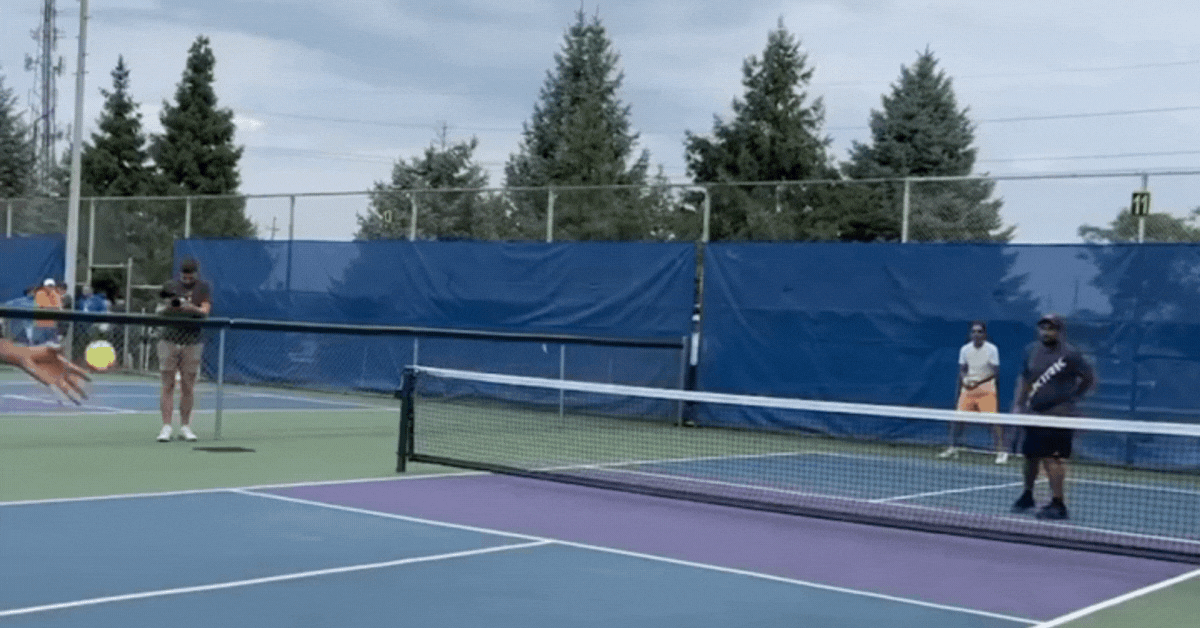
This is Zane Navratil hitting what is referred to as a "Nasty Nelson", which means he's pegging his opponent on the opposite side of the court he should be serving to. Yes, this is legal. But remember: if you miss, you fault and lose your serve! 🙂
Pickleball Serving: The Serving Sequence
In this section we will technically speaking be rehashing some of the things we learned in our pickleball scoring guide, but they are things we need to discuss for anyone who is strictly landing on this article and looking for serving-specific information.
So here's a quick breakdown of the serving sequence in pickleball:
- Each player gets a chance to serve and opportunity to score points until they possession is lost or they commit a fault (except on the first serve of the game in which only the first server gets to serve and after one lost rally the other team gets possession of the serve).
- The first serve of each serve possession for either team always starts on the right/even side of the court.
- Whenever a point is scored the serving team switches sides and the server continues serving from the other side of the court (and this continues as more points are scored).
- When a rally is lost, the first server loses his serve and the second server begins serving and repeats the process of serving until a rally is lost.
- Once both teammates get the opportunity to serve and they both lose their possession the ball/possession goes to the opposing team - this is called a "Side-Out" - and the player on the right side of the court begins serving.
Seems pretty easy, right?
Well, it truthfully doesn't get very difficult if you can understand this.
You should also always call the score before serving.
Which leads us to our next point...how to call the score.
How Do You Keep Score In Pickleball?
Or, something more people tend to ask "What is the third number in the score in pickleball?"
Obviously I shouldn't have to mention that this is a recap from our scoring guide, considering it's specific to score keeping, but it's going to be important to learn how to keep the score so that you can call the score on your serve.
When serving you'll want to say three numbers before each serve.
The first number is your score, the second number is your opponent's score, and the third number is the number server that you are for your team.
In pickleball singles you will only have to say your score and your opponent's being that there is only one server on each side.
Let's break it down...
If my team gains possession of the serve and I am the first server and the score is 6 to 3, with my team in the lead I would say: "Six, Three, One".
If I go on to win that rally, and therefore the point, I would switch to the left side of the court and call the score as "Seven, Three, One".
Next, if we then lose that rally and the serve goes to my partner on the right side of the court (we didn't switch positions because we lost the rally and only switch when we win a point), they would go on to call the score as "Seven, Three, Two", with two representing the fact that they are the second server.
And finally, if we then go on to lose that rally and the opposing team gets the serve back to them, the first server on the right side of the court would then call the score as "Three, Seven, One".
Who Serves First In Pickleball?
Being that we've discussed the start of the game and the first team serving only getting one serve to start, I should also discuss who serves first.
USA Pickleball creates the serving rules for pickleball and they state: "Any fair method can be used to determine which player or team has first choice of side, service, or receive. (Example: coin flip)".
Normally during rec play they will have a specific side of the court that always serves first, so if you start there, you're the team serving first.
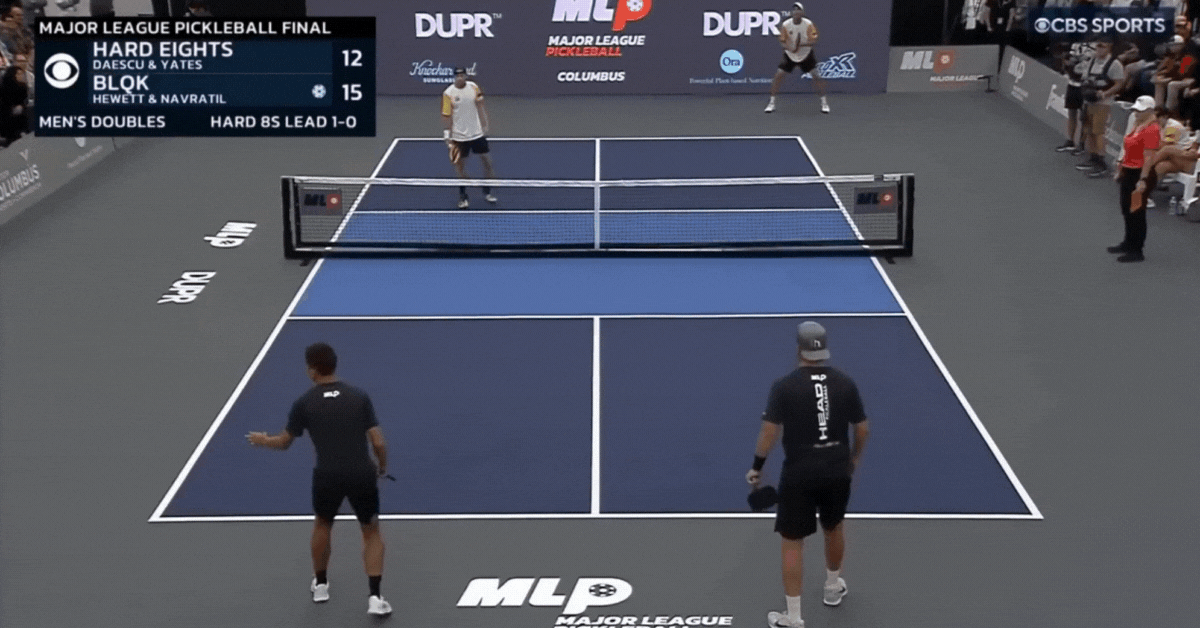
Pickleball Serving Rules: Types of Pickleball Serves - Volley Serve VS. Drop Serve
In the GIF above you'll see the spin GOAT of pickleball, Zane Navratil, utilizing the now illegal spin serve to make Andre Daescu (who is incredible, by the way) look silly.
We unfortunately won't be learning to look as Zane looks there, BUT, we will be learning about the two still-legal serve types: The Pickleball Volley Serve and The Pickleball Drop Serve.
I personally started with the drop serve, which a lot of players do - thinking it's easier to start with and get over the net - but I wish I went straight to the volley serve and recommend other players do as well.
Here's what each of them is, and a bit about their benefits:
The Volley Serve: The volley serve is when you hit the ball in the air out of your hand before the ball bounces. Similar to what I'll tell you about the drop serve: you cannot manipulate the ball out of your hand prior to hitting it. You also cannot hit the ball above your navel or hit the ball with the tip of the paddle being above the highest point of your wrist. This serve allows you to get the most power behind your serve and becomes a more consistent option. This is the serve option chosen by almost all professional players.
The Drop Serve: The drop serve is the opposite, where you let go of the ball, allowing it to bounce, and then hit the ball off the bounce. You are not allowed to spin the ball, throw the ball down for a bounce or any other manipulation of the ball other than a drop, but after it bounces all the other rules of the serve go out the window. This is generally found easier for beginners, and it also is usually easier to add spin to the ball.
The Spin Serve: Illegal. We will unfortunately never be as cool as Zane.
The BENEFITS OF Each Type Of PICKLEBALL Serve
The Volley Serve
More Potential Power
More Consistent (Eventually)
Better For The Two Most Popular Serves: Deep Topspin and Deep Targeted Power
Used By Almost All Pro Players*
The Drop Serve
Generally Easier For Beginners
More Slice/Spin Potential
Potential For Backhand Serves
Pickleball Serving Recap: A Recap To Pickleball Serving In Doubles and Singles Gameplay
If you're a visual learner like I am, you may want to refer to a video guide to help you learn more about pickleball serving and rules - and even some awesome tips.
For that reason, I embedded a video from one of my favorite YouTubers, That Pickleball Guy, above - who also made it on my list of the top ten pickleball YouTubers.
But, to recap, I do want to go over some of the basic things we learned for pickleball scoring.
- Points can only be scored by the team who is serving.
- When the non-serving team wins a rally the serving team switches servers or, if both players already served, it results in a "side out" which means the non-serving team wins possession of the serve.
- The first team to serve only gets one serve, as opposed to each player serving each time after a "side out" the rest of the game.
- The serving team switches positions on the court (right side is even side, left side is odd side) whenever they win points.
- The game always starts on the even side (right side) of the court, and whenever their is a side out and a team regains the serve, they also start on the right side of the court each time.
- The player serving the ball continues serving the ball until a rally is lost.
- The third number in the pickleball score only takes place in doubles pickleball, and it refers to the number server you are on.
- The score should be called by the player that is serving before they serve the ball each point.
- The serve must go to the opposite side of the court, serving diagonally at your opponent.
- The ball cannot land in the non-volley zone (aka the kitchen) or touch the kitchen line on a serve, but all other lines on the court are considered in.
- There is a two bounce rule during the pickleball serve which means the receiving team must let the ball bounce and then the serving team must also let the opposing teams return bounce as well.
- When serving you must make contact with the ball with the paddle below your navel and the tip of the paddle below lower than the top point of your wrist.
This list might seem a bit daunting, but once you get into the swing of things it actually becomes pretty easy, and you'll notice that a lot of them are pretty simple.
If you're interested in learning more about pickleball you can also check out our Pickleball Kitchen Rules (The Guide To The Non-Volley Zone), or even the top five tips to go from 3.0 to 4.0+ in pickleball.
And, of course, my favorite...if you're looking for the best paddle specifically for you, you can check out all of my pickleball paddle reviews or even take our Pickleball Paddle Quiz.
